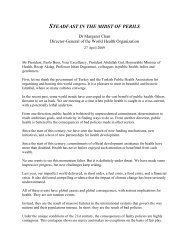The Evolution of HTA in Emerging Markets Health-Care ... - TREE
The Evolution of HTA in Emerging Markets Health-Care ... - TREE
The Evolution of HTA in Emerging Markets Health-Care ... - TREE
Create successful ePaper yourself
Turn your PDF publications into a flip-book with our unique Google optimized e-Paper software.
OHE Consult<strong>in</strong>g Report for PhRMA<br />
5 January 2011<br />
1932 CAPs were grow<strong>in</strong>g and 140 COPs covered almost 40.000 associates<br />
1933 Creation <strong>of</strong> the first Institutes <strong>of</strong> Retirement and Pension (IAPs), which was<br />
organized by work category. In these Institutes, the government also contributed<br />
with the f<strong>in</strong>anc<strong>in</strong>g <strong>of</strong> the system, ma<strong>in</strong>ta<strong>in</strong><strong>in</strong>g also the contribution from employers<br />
and employees. With the creation <strong>of</strong> IAPs, the government centralized health<br />
<strong>in</strong>itiatives, hav<strong>in</strong>g as primary <strong>in</strong>terest the creation <strong>of</strong> a social <strong>in</strong>surance system that<br />
guaranteed the health <strong>of</strong> workers.<br />
1949 Creation <strong>of</strong> the Service <strong>of</strong> Domiciliary Urgent Medical Assistance (SAMDU), which<br />
def<strong>in</strong>ed the right to medical assistance <strong>in</strong> case <strong>of</strong> urgencies for all citizens and was<br />
f<strong>in</strong>anced by all IAPs together.<br />
Until 1960<br />
Predom<strong>in</strong>ance <strong>of</strong> IAPs, which privileged social security <strong>in</strong>stead <strong>of</strong> health care<br />
1960 All IAPs were centralized <strong>in</strong> a unique State <strong>in</strong>stitution, creat<strong>in</strong>g the National Institute<br />
<strong>of</strong> Social Security (INPS), which centralized health care provision for workers that<br />
contributed to the system.<br />
With this, there was the creation <strong>of</strong> the health care provision system, composed by<br />
three systems: proprietary (hospital network and health units property <strong>of</strong> Social<br />
Welfare, as well as pr<strong>of</strong>essionals receiv<strong>in</strong>g wages from the State), accredited<br />
contractor (system <strong>of</strong> payment by service units), and “conveniated” contractor (pre-payment<br />
system).<br />
1977 Creation <strong>of</strong> the National System for Pension and Social Assistance (SINPAS), which<br />
segmented actions related to pensions and to medical assistance. It was composed<br />
by the Institute <strong>of</strong> F<strong>in</strong>ancial Adm<strong>in</strong>istration <strong>of</strong> Social Security (IAPAS) and by the<br />
National Institute <strong>of</strong> Medical Assistance (INAMPS). INAMPS cont<strong>in</strong>ued to privilege<br />
“conveniated” private providers to <strong>in</strong>crease the number <strong>of</strong> providers for the State.<br />
<strong>The</strong> system started to grow with private capital <strong>in</strong>stead <strong>of</strong> <strong>in</strong>vest<strong>in</strong>g <strong>in</strong> improv<strong>in</strong>g<br />
public providers.<br />
1980 <strong>The</strong> system provides poor health care, with long wait<strong>in</strong>g lists, low wages, bad work<br />
conditions, generat<strong>in</strong>g grow<strong>in</strong>g dissatisfaction <strong>of</strong> the population with the quality <strong>of</strong><br />
medical assistance. F<strong>in</strong>ancial resources were mismanaged and cases <strong>of</strong> corruption<br />
started to be frequent. Besides that, the population was ag<strong>in</strong>g and the first<br />
contributors to the pension system were start<strong>in</strong>g to retire and receive their<br />
pensions, for which there was not enough money.<br />
1980’s Sanitary Movement: With political open<strong>in</strong>g, movements <strong>in</strong> defence <strong>of</strong> a broader and<br />
democratic health policy are formed. In 1979 they proposed a structure for a new<br />
Unified <strong>Health</strong> System, <strong>in</strong>corporat<strong>in</strong>g successful <strong>in</strong>itiatives from other countries,<br />
such as the universal right to health, <strong>in</strong>tegrity <strong>of</strong> actions, and democratization <strong>of</strong> the<br />
system.<br />
<strong>The</strong> prioritization <strong>of</strong> the government <strong>in</strong> previous years for the private capital <strong>in</strong><br />
health care, however, created strong <strong>in</strong>terests aga<strong>in</strong>st changes <strong>in</strong> the system that<br />
bought pr<strong>of</strong>its to private hospitals.<br />
81








